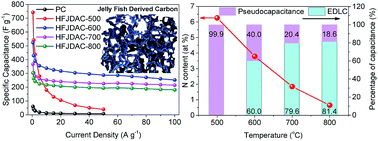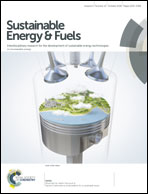Boosting pseudocapacitive charge storage in in situ functionalized carbons with a high surface area for high-energy asymmetric supercapacitors†
Abstract
Achieving both a high surface area and high heteroatom doping in carbon materials is a major challenge for aqueous-based supercapacitors. Herein, we choose an efficient carbonization–activation pathway to tune the porosity and heteroatom doping level of carbon materials by using jellyfish as the precursor and KOH as the activating agent. Highly Functionalized Jellyfish-Derived Activated Carbons (HFJDACs) possess a high surface area of up to 3300 m2 g−1 with nitrogen and oxygen heteroatom doping. Carbon activated at 500 °C displays a capacitance as high as 743 F g−1 and 639 F cm−3, while carbons activated at a temperature higher than 500 °C exhibit a favorable capacitance retention of >48.1% at 100 A g−1. These values are among the highest reported in the literature, and therefore these carbon materials can be used as the ideal negative electrode in asymmetric supercapacitors to circumvent the capacitance mismatch between oxide-based positive electrodes and carbon-based negative electrodes. The assembled asymmetric capacitor employing HFJDACs can achieve a high energy density of 43.4 W h kg−1 and an amazing cycle life with capacitance retention of 110% after 20 000 cycles. These results demonstrate that adapting a scalable synthesis strategy for designing carbons with well-developed porosity and high level heteroatom doping is promising for advanced supercapacitors.



 Please wait while we load your content...
Please wait while we load your content...